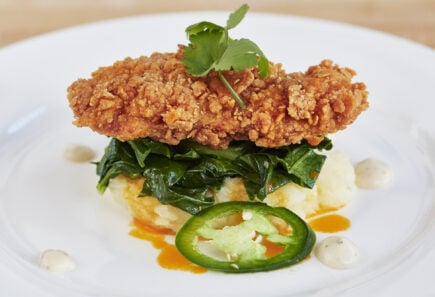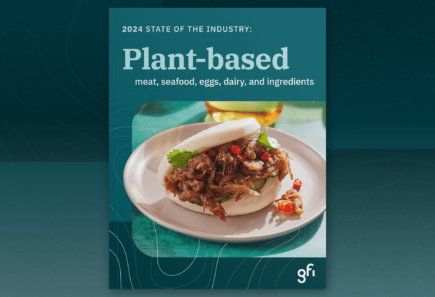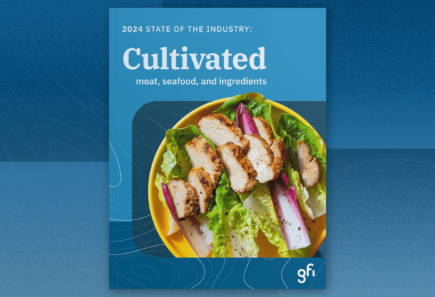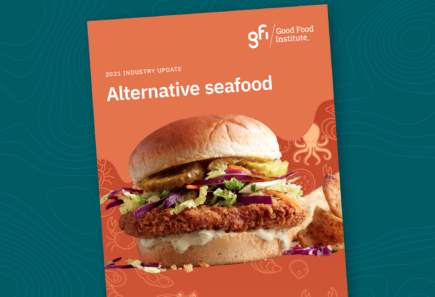
Laying the foundation for a strong student group
This guide will help you navigate thet early stages of running your student group. Follow these steps to jumpstart your new organization, build leadership skills, maximize your impact, and keep your group operating effectively.
How students can build the alternative protein field
As a member of the academic community, you’re particularly well-suited to make a positive difference in the way we feed our world. Academic institutions hold the technological keys to unlocking alternative proteins that are tastier, cheaper, and more widely available than ever before. You can help turn those keys. We see great potential in student groups to provide peers and researchers with a community in which to apply their academic expertise to alternative proteins. At their best, student groups also act as miniature think tanks for a burgeoning field, catapulting their members to the forefront of the alternative protein movement. With the help of a global community, our student leaders build teams of peers and faculty to accelerate our planetary transition to a sustainable, secure, and just food system.
How this guide will help
You’re reading this guide because you want to lay the foundation for a strong community centered around alternative proteins at your university. Whether or not your student group has applied and been accepted into the Alt Protein Project, we’re here to help! The goal of this guide is to walk you through the early steps of running an inclusive, vibrant, and long-lasting campus community. We hope this guide will be beneficial for all alternative protein-focused student groups—regardless of affiliation with GFI—but please keep in mind that some sections may only apply to chapters of the Alt Protein Project.
Our core objectives
The five objectives below allow us to mobilize the next generation of scientists and innovators from every discipline to overcome the most pressing challenges facing our food system today.

Objective 1: Building alternative protein courses and majors
One of the largest bottlenecks in the alternative protein field is the relative lack of scientists and engineers who can advance plant-based, cultivated, and fermentation-enabled meat, egg, and dairy products. The Alt Protein Project works to create and support alternative protein courses, tracks, and programs. Student leaders work with GFI experts and university faculty to design course materials and advocate for curriculum development.

Objective 2: Stimulating open-access research
The alternative protein field needs more scientists driving open-access academic research for better alternatives to conventional meat, egg, and dairy products. Student leaders play a pivotal role in catalyzing open access research by inspiring academic collaborations, designing research proposals, laying the foundation for research centers and consortia, keeping labs abreast of new funding opportunities, and pursuing their own lines of scientific inquiry.

Objective 3: Catalyzing alternative protein entrepreneurship
The Alt Protein Project empowers student entrepreneurs to start alternative protein companies that address key commercial white spaces whose solutions will help propel the industry forward. Students can do this in a myriad of ways—by working with alternative protein experts to analyze white space opportunities and develop product prototypes, mobilizing their peers through regional innovation challenges, building alternative protein tracks in student accelerators, and more!
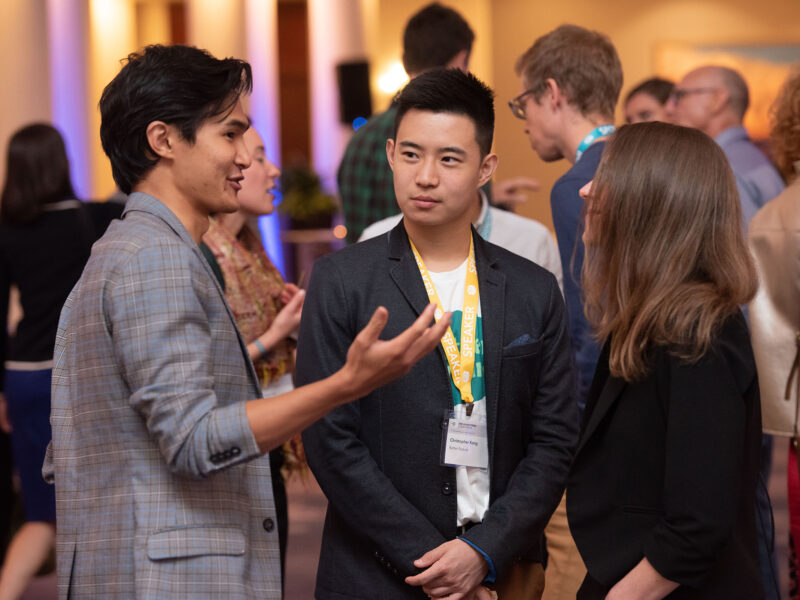
Objective 4: Generating awareness and excitement
The Alt Protein Project organizes events and conferences to stimulate discussion, cultivate new ideas, and get people excited about opportunities in alternative proteins. Generating enthusiasm on campus means that more students can take advantage of the university environment to explore alternative protein white spaces, both within and beyond the Alt Protein Project.

Objective 5: Creating an inspiring, inclusive community
The Alt Protein Project provides students and researchers with a fun, fulfilling, and inclusive community in which to explore questions and opportunities around alternative proteins. Student groups welcome a diverse and interdisciplinary membership to spur novel thinking, break down academic silos, and foster collaboration.
Guiding philosophies
Because each campus has unique needs, the ideal student group at any given university will have its own characteristics. These are some principles we believe will serve every group well.
- We are forward-thinking. Many groups will have regular meetings in which members discuss current research needs and opportunities within the alternative protein field. In these meetings, and in other events, keep one eye on the path forward. How can your group members set themselves up to become more involved in the future?
- We are inclusive. Diversity in all its forms is crucial for thinking outside the box. Groups should be comprised of members with all manner of cultural and personal identities, academic interests, personal passions, and dietary requirements and habits. The more perspectives members bring to a given group, the more innovative that group can be.
- We are counterfactual impact-driven. We use evidence and reason to guide our work and rally students around the most high-impact activities that really only they can do, and do well. Our student groups work to ensure that researchers and innovators at their universities are pursuing solutions to the most critical challenges — solutions that will help us overcome technical and commercial bottlenecks and accelerate our food system’s transformation.
- We share knowledge freely. Any materials that a university student group produces should be freely accessible to both members and non-members. We encourage groups to contribute templates, tools, and general tips and tricks to our resource hub. Wherever relevant, promote the sharing of ideas and insights for the betterment of a group’s mission.
- We are creating an animal-free food system. Alternative proteins eliminate a key driver of zoonotic diseases, antibiotic resistance, and environmental impact—using animals for food. The risks to global health and environmental sustainability are too high for us to rely on incremental improvements to conventional animal agriculture. Our student groups focus on radical, paradigm-shifting technologies that eliminate the need for farmed animals, thereby decoupling food production from the risks and harms associated with conventional animal agriculture.

Semester 1 gameplan
This section of the guide will walk you through the first 4-6 months of running your student group. These are four important areas to focus on during your first semester:
Starting your group
To help you get started, we’ve identified four essential steps for your group to complete in its first month to be well-positioned for long-term success. This section will lay out the steps for crafting a mission statement, finding a faculty advisor, establishing your group as an official student organization, and assembling a leadership team.
Crafting your mission statement
Articulating your group’s purpose
Your group’s mission statement acts as your north star while you build a vibrant alternative protein community on campus. It can inspire you, your fellow leaders, and your membership to dream big while keeping your group’s goals at the center of your work. A well-crafted mission statement can also help you make decisions when you’re faced with trade-offs.
Sample mission statements
Below are some examples of mission statements that might apply to your university. You can combine, alter, and build from them as needed depending on the goals of your group and the context of your campus.
- The Alt Protein Project strives to build a healthy, sustainable, and just food system by creating a vibrant and robust community for alternative protein research and education.
- The Alt Protein Project is mobilizing the next generation of scientists and innovators from every discipline to plan future careers that will allow them to transform the future of food.
- The Alt Protein Project is a group of student researchers and entrepreneurs focused on building the next alternative protein hub in the region.
How is your group uniquely situated to expand the frontiers of alternative proteins?
Whether you choose to use an altered version of the provided statement or write a new one entirely is up to you. If you choose to include your own language, make sure that promoting alternative protein research, education, and innovation remains a linchpin of your student group. Then, think about what makes your group unique. What expertise will your leadership bring to the table? What are the distinctive strengths of your university? Consider your geographic region—are you located near relevant companies, research labs, or economic development organizations?
If you’re having trouble answering these questions, flip through our guide on mapping your university ecosystem. Completing the entire exercise might be too big a project at this stage, but glancing through this guide will help you recognize the people, departments, and resources that make your group uniquely positioned to improve our global food system. The section on maximizing your counterfactual impact will take you through this exercise in more detail.
Finding a faculty advisor
The ideal faculty advisor
Finding an engaged and enthusiastic faculty advisor can take your student group from good to great. A faculty advisor can support your group’s leadership and membership in navigating the administrative systems at your university, identifying practical ways to get hands-on research experience, and advocating for your group as you embark on more ambitious projects. All student groups accepted into the Alt Protein Project are required to secure a faculty advisor.
An ideal faculty advisor should be passionate about the alternative protein field, enthusiastic about student enrichment, and well-connected across various academic departments. We also recommend you seek out a faculty advisor in one of the key disciplines for alternative proteins.
For more tips on searching for potential faculty advisors, take a brief look through our guide on mapping your university ecosystem—but don’t feel pressured to complete the entire exercise at this stage. Later on, you’ll embark on an ecosystem mapping project as the first step to maximizing your counterfactual impact.
Faculty advisor outreach
To find the right match, first identify three potential faculty advisors to approach. These should be people with whom you have positive preexisting relationships or people with a reputation for engaging enthusiastically with students. They should also be people that you like or with whom you anticipate you can work well. Ideally, they should also be able to help your group get access to kitchen or lab space.
Then, write out your “ask.” You’ll want to come to a potential faculty advisor with a clearly articulated list of responsibilities they’ll be expected to take on if they accept the role. You should also be able to explain how the advisor will benefit from this role. To help you get started with faculty outreach, we’ve provided an email template.
Prepare to hear and accept “no” as an answer—and to maintain a line of communication anyway. There are many reasons a faculty member or administrator might not be able to take on the responsibility of sponsoring a student organization, but that same person might still be happy to participate in organization meetings or support your group in other ways.
GFI support for faculty advisors
If your faculty advisor is new to the alternative protein space, consider introducing them to GFI. We have a plethora of resources to share, and we’d love to explore new opportunities to support faculty advisors in our ecosystem. To set up an introductory meeting, contact us and carbon copy (cc) your faculty advisor.
Becoming an official student organization
How to register your student group
Now that you’ve found a faculty advisor, you can move forward with the formal process of establishing a student organization on your campus. This process looks different at every university; specific instructions are usually provided by an office of student affairs, a center for undergraduate activities, or a similar administrative group.
Early on, you should identify the administrators who can guide you through any bureaucratic hurdles. You can also reach out to peers who have successfully started their own student organizations to learn from their experiences. For reference, here are a few examples of processes to set up student organizations at different universities: University of the Philippines Diliman, National University of Singapore, MIT, Northwestern, Texas A&M.
Global considerations
Keep in mind that student organizations are more common in the United States than in most other countries. Universities in other regions might have more prerequisites for new student organizations, such as creating a formal corporation in the country where your campus is located. These types of requirements can take many months to complete.
Fortunately, you can start running your student group before your organization is officially registered with the university. There may be some restrictions around using your university’s name or logo in your branding, and some sources of funding may be unavailable until you are formally registered. Check out the section on operating your group for other ways to secure funds. If you have any tips for new student groups having trouble establishing their organization, please share them with us!
Student group registration guidelines
Below are some rules to look out for as you register your organization with your university.
- Student group charter: Does your university require a written charter or constitution that explains the purpose and intention of your group? We’ve created a sample charter you can use if you need inspiration to write your own document.
- Time window: Is there a specific period during which students are allowed to apply for official recognition for their organization? Some universities will only consider new groups in the first few weeks of a semester (or even an academic year).
- Funding: Do you need to secure funding before establishing your group? If so, your office of student affairs will be able to walk you through the process of applying for resources. (This consideration is separate from finding sources of ongoing funding to run your group—those will be discussed in the section on operating your group)
- Naming: What are your university’s rules regarding the use of its name in your group? Be extremely careful when using your institution’s name, and check with relevant administrators before you submit any application paperwork that uses the name. Where possible, student groups accepted into the Alt Protein Project should name their club “The [University Name] Alt Protein Project”. You can find more information about how to name your group in our brand guidelines.
- Membership minimum: Some universities may require that you have more than just a pair of co-founders to establish a group. They may also require that roles like “secretary” or “treasurer” be filled. Continue to the next section on assembling a successful leadership team for tips on filling these roles.
Your group will be subject to university rules after you’ve applied to be a formal organization. Make sure you consistently comply with any regulations your university has and that all new members are aware of these regulations.
Assembling a leadership team
Identifying potential leaders
Finding other students who share your passion for transforming the future of food can feel daunting—especially if alternative proteins don’t have high visibility on your campus.
In the early stages of movement-building, you may not find students identifying themselves as advocates for alternative proteins. Your future team members are more likely to be involved in student organizations related to climate change, animal welfare, food insecurity, and other cause areas affected by industrial animal agriculture. They may also be students who are passionate about intellectually compelling scientific questions; you might find them in the chemical engineering club or other technical project groups.
To find team members with relevant backgrounds for alternative protein innovation, reach out to organizations related to these key disciplines. You can also find mission-aligned individuals in the effective altruism (EA) community; search the local EA directory to see if there’s a group at your campus.
The ideal leadership team
Once you’ve identified a few potential candidates, here are some considerations for building a strong leadership team.
Mission alignment: Pick someone who is passionate about creating a world where alternative proteins are no longer alternative. If you or your teammates are just doing this to fill in the “volunteer” section on your LinkedIn profile, it’s much more likely that one of you will take ill-advised shortcuts or bail out when you’re crunched for time.
Availability: Are you and your teammates all taking five classes, including organic chemistry? Then regardless of how enthusiastic you are, this might not be a viable dream team. Student leaders should treat this group like another class: it will require a few hours of paperwork to establish an official university student group, more hours of planning for group meetings, and even more time if you want to launch ambitious research and education initiatives on campus.
Complementary skill sets: The most passionate people in the room don’t always make the best group leaders. We recommend taking stock of the responsibilities involved with running a student group and assessing whether your leadership team has the complementary skill sets to make your vision a reality.
Responsibilities may include:
- Creative problem-solving with limited resources.
- Energizing and inspiring your peers.
- Paperwork, especially official registration work for the organization.
- Financial responsibility, ranging from the handling of receipts to applying for funding.
- Logistical planning, such as booking rooms, securing food, and delegating tasks for meetings and other events.
- Advertising and recruiting, including securing slots in activities fairs and designing posters or other recruiting material.
- Facilitating discussions with students and researchers about the challenges and opportunities around alternative proteins.
And more! Check out our objective-level resource guides for more information on the key responsibilities and opportunities associated with running a student group.
Officer elections and removals
If your group is just getting started and there aren’t enough members to hold an officer election, your co-founding team can appoint student leaders to serve for the first year. But going forward, you might choose to hold elections before the end of the academic year. Officer selection procedures should be defined in your student group’s charter or constitution. To learn more, jump ahead to the “Planning for the future” panel in the section on operating your group or check out the University of South Carolina’s guide on student organization elections.
Your team should also establish grounds for removal of officers who aren’t performing their duties adequately. Ideally everyone will stay committed to their role, but you don’t want to be caught without a plan if a teammate is underperforming. Procedures for removing officers should also be included in your student group’s charter or constitution.
Being an effective leader
Each student group in our community is pursuing a set of wildly ambitious goals, which means effective leadership is critical for advancing these objectives. This section will offer guidance on managing a successful leadership team, from building an organizational structure to creating a healthy and energizing team environment. In addition to reading this guide, we also recommend visiting your university’s student affairs office; they may offer workshops on public speaking, interpersonal communication, and other important skills for student leaders.
Building an organizational structure
How to organize your team
Your student group’s efficiency is highly dependent on how you organize your leadership team, so it’s important to establish a clear structure from the get-go. An organizational structure should explain who reports to whom, how committees are divided, and what the high-level responsibilities are for each role.
Many of the student groups in our community use the hierarchical-divisional structure depicted below. This structure can be advantageous because the chain of command and division of committees are clearly defined. Note that the director roles correspond to the Alt Protein Project’s five core objectives: community, courses, research, innovation, and awareness. This helps ensure each officer is laser-focused on advancing their committee’s core goal.

You might not find people to fill all the positions right away. Take note of these open positions and advertise them in future general meetings or hold a meeting for interested board members.
Delegating roles and responsibilities
The importance of delegation
It’s not uncommon for newer leaders to struggle with task delegation. Maybe you think explaining the task would take longer than doing it yourself, or perhaps you feel guilty about adding more work to your teammate’s plate. To counter these hesitations, try to remember that effective delegation will allow your group to make larger strides toward a more sustainable and resilient food system.
While it may seem counterintuitive, being less involved with day-to-day activities may allow you to make a greater impact. By delegating, your teammates will be more engaged knowing you trust them to get the job done. You’ll also create space for those tasks that fall into the “urgency trap”—like strategic planning and process optimization. To read more about how delegation results in better-performing teams, check out Harvard Business School’s blog post on effective delegation for managers.
Essentialism
Part of effective delegation is prioritization. As part of the Alt Protein Project, you’ll likely find yourself with more opportunities than you can reasonably say “yes” to. Successful student leaders know how to sift through the abundance of potential projects, collaborators, and opportunities and home in on the most impactful ones. Our number one recommendation is Greg McKeown’s formulation of essentialism, the disciplined pursuit of less—but more targeted and effective—work. Instead of making a millimeter of progress in a million different directions, you can direct that same amount of effort in fewer directions and make significant progress in what matters most. Be extremely selective about taking on new tasks, and only say yes to tasks that are essential to your goals.

The graphic below can help you shift from a non-essentialist mindset to an essentialist approach to life and leadership. Go over these principles with your leadership team, and reexamine your group’s priorities if officers feel pulled in too many directions.

Deciding when to say “no”
Here are some questions to help you decide whether to decline a non-essential activity or request:
- Does this activity directly contribute to one of my or my team’s top priorities? If it fits with a top priority for the team, but not with one of your top priorities, then delegate to a teammate who has this area as a priority.
- What is the counterfactual value of me responding to this request? Will the requestor be able to find what they need elsewhere? If so, then taking the time to support them doesn’t actually move the needle for meeting your mission.
If you’re still on the fence about what to do after considering those primary questions, a few more questions that might factor into your decision may include:
- Is this something I really enjoy doing? In some cases, the activity itself may be of only moderate impact value, but it gives you energy and purpose that — in the long run — keep you at your best. If you would feel energized by accepting this request, go for it!
What would my faculty advisor do? Remember that you can always get input from your faculty advisor. That’s one of their main responsibilities: to coach your group through deciding what to say yes to, what to decline, and how to prioritize your activities.
Effectively delegating tasks
Everyone has a different set of jobs that they enjoy doing or that they are particularly well suited to. If you can assign responsibilities so that each person spends most of their time doing what they do best, your team’s productivity and potential for impact will increase.
Start by taking stock of the strengths and preferences of each person in your leadership team. Is one officer energized by approaching strangers? They should be in charge of member recruitment. Is another officer more reserved and detail-oriented? They should handle logistical planning for meetings and events. Is another officer hoping to strengthen their management skills? They should lead a committee or project team.
You might have remaining tasks that none of your teammates love doing—like paperwork—but hopefully this exercise offers each person opportunities to do work that excites them. Distribute the undesired tasks fairly, and encourage your leadership team to speak up if they have issues with their assigned responsibilities. UC San Diego has a collection of leadership tip sheets that cover best practices for effective delegation.
Tips for communication and conflict resolution
Setting norms around team communication
You and your teammates likely have different preferences around team communication. Perhaps one officer tends to send lengthy emails, while another officer would rather receive verbal instructions. If any expectations around communication are unclear, each person will fill in the blanks with their own assumptions. This sets the stage for a communication breakdown, which can have a ripple effect on your team.
Fortunately, you can prevent communication breakdowns by setting healthy norms. The best time to establish ground rules is when your team is just getting started. The most effective norms are specific and agreed upon as a group. Here are some examples of clear communication norms:
- “One day before a leadership meeting, the agenda owner should provide a brief background so attendees are clear about what will be discussed and have time to process the agenda items beforehand.”
- “Officers should try to reply to emails within 48 hours. If you need more time, consider emailing the initial sender to inform them you’ve received their inquiry and will get back to them soon once you’re able to discuss the matter with your team.”
- “For transparent communication, communicate in threads and channels on Slack. There is no expectation to be online at specific times or respond to chats immediately. If you need an urgent response from someone, reach out via phone or text.”
Once your team’s group norms have been established, make sure they’re written down and easy to access. Revisit these ground rules on a regular basis and amend them as needed. If your leadership team has any norms that have improved the way your group interacts, please share them with us!
Making decisions
Even if your leadership team agrees on the overall vision for your group, deciding how to implement it can be a source of conflict. You may also find that your team experiences decision fatigue in a certain area and can’t choose what to do even though no one has a strong opinion. We recommend establishing a decision-making framework before these issues arise.
The purpose of a decision-making framework is to create an environment in which debate and disagreement do not lead either to resentment or to prolonged indecision, as well as to clearly designate responsibility for which leaders make which decisions. While your team may want to create its own system based on the ways you work well together, we suggest that you draw inspiration from existing frameworks used in successful organizations. Check out writing on the subject from McKinsey and Harvard Business Review to get started.
Preventative planning
During the academic calendar, people get sick, coursework takes longer than expected, personal emergencies arise, energy levels dip, and moods sour. You should be able to discuss these inevitable problems with your leadership team before they arise. Here are some questions you might want to ask early on in the process of founding a student group:
- Does our timeline have slack built into it in case one of us has less availability than anticipated?
- How will we redistribute work if one of us is unable to complete certain tasks?
- How will we handle disagreements?
- What motivates us? When we feel frustrated, overwhelmed, or discouraged during this process, how can we support each other?
Write down your expectations for one another and your strategies for holding each other accountable. This can help prevent disagreements that often arise during stressful parts of the year.
Conflict resolution
Many of us cringe at the thought of interpersonal team conflict, but it’s important to recognize that not all conflicts are unhealthy. When handled respectfully, conflicts can actually be a healthy indicator of community trust and diversity—disagreements won’t surface if people don’t feel safe speaking up or if everyone has the same opinions.
Here are some quick tips for resolving conflicts:
- Address the conflict early on. If possible, discuss the issue in person to avoid ambiguities from written communication.
- Remain calm and use neutral language; otherwise you will likely escalate the conflict. If you’re unable to remain calm, remove yourself from the situation until you feel able to have a civil conversation.
- Be an active listener. Be mindful of body language, ask clarifying questions, and avoid interrupting the other speaker.
- Separate the person from the problem. Address the specific behavior rather than assigning negative feelings to the person responsible for the issue.
For more guidelines on conflict resolution, Ithaca College created a resource on conflict management for student organizations.
Fostering a fun and inclusive team culture
Building a healthy environment for your team
A core objective of the Alt Protein Project is to create a fun, fulfilling, and inclusive community—and this begins with student group leaders. In a healthy team environment, everyone should feel safe, valued, and empowered to grow. If your leadership team has a harmful culture, any negativity is likely to percolate into the broader community.
There are countless factors known to affect the health of a team culture, so this section will focus on two areas we believe are especially relevant for student groups in our community: boosting morale and promoting inclusion.
Keeping up morale
Performing well as a team doesn’t always generate enthusiasm and motivation among your teammates. The reality is that many day-to-day responsibilities of running a student group are not very glamorous. For instance, emailing twenty potential course instructors and receiving zero replies might not elicit enough inspiration to email twenty more instructors. But that next round of outreach could very well lead you to a professor who agrees to teach your proposed course. So what steps can you take to keep the momentum going when your leadership team needs a morale booster?
Here are three tips to keep in mind:
- Make time for fun! Don’t let this be an afterthought; intentionally reserve space for fun, informal activities in your team calendar. There are plenty of opportunities to bond over food, from alternative protein product tastings to holding a leadership team meeting at a plant-based eatery. Feel free to choose an activity that isn’t related to alternative proteins, like a short backpacking retreat or escape room. As long as you’re having fun and making time to see each other as full human beings, your leadership team will grow closer and have an easier time maintaining morale.
- Celebrate the smaller victories. Recognizing the progress you’ve made is a reliable way to feel good about your work, but it’s easy to overlook small wins. The core objectives of the Alt Protein Project often unfold over a long time horizon, so if you only acknowledge big milestones—like starting a new course—your celebrations will be few and far between. Make a habit of giving teammates kudos for taking steps in the right direction; you can create a #smallwins channel on Slack or begin each meeting by sharing tiny victories. Remember that no win is too small to celebrate!
- Prioritize psychological safety. This refers to how a teammate perceives the consequences of interpersonal risks, like suggesting a new idea or owning up to a mistake. Google’s study on effective teams revealed that psychological safety is the most important factor impacting team performance. Student leaders with marginalized identities are more likely to feel psychologically unsafe, and diversity by itself will not fix this issue. The key factor is inclusion, which will be further explored below.
Creating a truly inclusive team culture
It’s worth restating: for a diverse team to feel safe, an inclusive culture is absolutely vital. On inclusive teams, each person feels welcome, respected, and able to thrive. For this reason and more, inclusion is a guiding principle for the Alt Protein Project and a key characteristic of the alternative protein communities we strive to build.
Many organizations neglect inclusion and focus only on diversity. Unfortunately, this can cause more harm than good. People from underrepresented groups who join non-inclusive teams often report feeling unvalued and unable to express contrary opinions, leading to low team satisfaction and retention. When teams are truly inclusive, members have a sense of safety, facilitating greater levels of authenticity, participation, and creativity.
Here are some skills your team can develop to promote an inclusive culture:
- Recognize and understand differences. Leaders can practice this by self-disclosing differences with their team. You can start by revealing something about yourself that is low-stakes but unusual, like a guilty pleasure. From there, you can normalize sharing details that might allude to differences in race, class, ability, and other identities—such as weekend plans or family traditions. Be sure to affirm your teammates when they disclose their own differences.
- Share the spotlight. Recognize your teammates for the amazing contributions they make. If someone gives you all the praise for a team effort, make sure to give a shout out to each person who contributed so no one feels left out.
- Give everyone opportunities for growth. Remember that this program is a professional development opportunity for everyone involved. Provide each person with opportunities to develop in ways they are truly excited about, and pay special attention to ensure folks with marginalized identities feel empowered to grow.
- Practice active listening. Give your teammates your full attention when they’re speaking, and restate what you hear so they know you understood their point. Demonstrate interest by asking follow up questions. Recognize and show your appreciation when teammates display honesty and vulnerability.
- Invite difficult conversations. No matter how uncomfortable it feels to address a conflict, avoiding the matter is not an effective way to foster an inclusive culture. Take extra care to address issues related to diversity and personal identities. Not every conversation will go perfectly, but practice and support will help make these moments easier. Read this article by the American Association of University Women for tips on navigating these conversations.
We’d love to hear from you if you have additional tips for building an inclusive culture.
Maximizing your counterfactual impact
In order to make the most meaningful difference, it’s important to take a step back and build a thoughtful plan before you begin your alternative protein initiatives on campus. Follow the steps below to build a deep knowledge of your university landscape, chart a clarifying strategy for the road ahead, and amplify your creations and learnings so that your world-building work can reverberate across our global community of alternative protein movement-builders.
Mapping your university ecosystem
Learning the ins and outs of your university
Ecosystem mapping is crucial for understanding the people, departments, offices, funding opportunities, and other puzzle pieces that can be mobilized in service of your field-building projects. Charting the topography of your institutional landscape in this way will help you elucidate the relationships and connections that exist, or could exist, to grow alternative protein activity on campus.
Once you deepen your understanding of your university’s strong suits, existing academic and research infrastructure, and available programs and resources, your group will be able to build a thoughtful strategic plan to illuminate the roadmap ahead.
Leverage the guide below to map your university’s ecosystem. You should emerge with a deep foundational knowledge of your university landscape and network of potential collaborators. If done well, your student group should only need to complete the ecosystem-mapping exercise once. Whether you use our guide or create your own from scratch, remember to share this knowledge base with every generation of your leadership board to eliminate the need for future duplicative efforts.
Building your strategic plan
Developing a roadmap
Once you have a sense of the puzzle pieces at your institution, it’s time to assemble them and build a roadmap for the year ahead. Leverage the strategic planning template to house your master plan. It will help you select broad objectives; identify and prioritize the most impactful actions; craft your organizational structure, roles, and responsibilities; and map your action roadmap to a tentative timeline.
Ideally, you will work through this exercise as a team with input from all active members. We recommend budgeting 3 hours to complete this exercise. In order to support your efforts, here is an example of a completed plan for reference.
Counterfactual impact
As you plan, remember to consider the counterfactual value of everything we do. Just because we can do something doesn’t mean we always should. Likewise, just because something feels super valuable doesn’t mean it’s necessarily the most valuable thing to do. If the activities you’re contemplating are likely to unfold without your efforts, then taking the time to do them wouldn’t actually move the needle for our collective mission. After all, every minute we spend doing moderately impactful things means we have one less minute to spend working on things that drive the highest impact.
As you identify your group’s objectives and actions for the year, be sure to reference the objective-level guides in our resource hub to access step-by-step models for the most high-impact actions students can take to make a difference on the trajectory of our food system.
If at any point you’re unsure about the counterfactual value of your strategy, you can always reach out to GFI for feedback. It’s one of our main responsibilities to coach you through decisions, what to decline, and how to prioritize your activities among all the great things you could spend your time doing in service of our collective mission.
The planning fallacy
Remember to also budget 50% more time than you anticipate you’ll need to complete your actions. This is meant to contend with the planning fallacy, whereby people are overly optimistic about the time needed to complete a task. Addressing the planning fallacy requires re-thinking what we believe we can actually do in a day, week, month, or semester. If you end up with extra time leftover, it will feel like a bonus!
Tracking your impact
The importance of impact tracking
As your student group embarks on bold, game-changing initiatives at your university, you’ll want to keep track of your accomplishments—big or small—as their effects reverberate across the alternative protein ecosystem. Impact tracking can help your group and the broader student community stay focused, track progress, and understand what works and what doesn’t.
Impact tracking is also invaluable for preserving institutional memory, which can be thought of as a library of information containing insights, experiences, skills, knowledge, and relationships gathered through your group’s alternative protein ecosystem-building efforts. Creating a rich repository of knowledge will make it easier to coordinate across your team and ensure a seamless transition for future student leaders.
How to track your impact
To help you with this process, we’ve designed an impact tracking template for your student group to maintain records of overall impact, add status updates, and store important information about the relationships you’re building.
Use the impact tracking template to log progress towards building an alternative protein ecosystem at your university. The template contains three separate sections: a key numbers tab, a progress updates tab, and a contacts list tab. We encourage you to copy the template, adapt it to fit your group’s needs, and update it monthly to summarize (and celebrate!) your student group’s accomplishments. On a bi-annual basis, Alt Protein Project chapters will submit a group impact reporting form that summarizes quantitative and qualitative accomplishments over the prior 6 months.
- The key numbers tab is where you’ll capture your group’s measurable impact. The quantitative data we collect in the bi-annual group impact reporting form will map closely onto the fields in this tab, so we don’t recommend removing any fields. We also provide space for you to add any qualitative information that clarifies what you’ve counted. If your group would like to track additional metrics, we encourage you to add ancillary fields as needed.
- The progress updates tab has a space for your group to provide details about your ongoing activities each month. Each progress update is divided into the five core Alt Protein Project objectives: education, research, innovation, awareness, and community. The impact tracking template contains more detailed information about what these objectives mean to help you determine under which objective-specific actions fall.
The contacts list is a space to keep records of your outreach and engagement efforts, whether with individual researchers at your educational institution or alternative protein companies in the surrounding region. These fields will help you log your communications with collaborators so that current and future members of your group can easily access this knowledge and understand the relationships your group is building as a collective. Feel free to adapt the fields as you see fit so that they become maximally useful for your student group.
Sharing what you learn
Contribute to our global community
You are part of a broader network of changemakers building the world we collectively know is possible. With the Alt Protein Project, we champion a culture of close collaboration and open sharing so one person’s work can ripple across the entire alternative protein ecosystem for the benefit of all.
Sharing what you learn will 10x your individual impact, make it easier for other groups to benefit from your experiences, and help us co-create a sustainable, secure, and just protein supply faster than we could if we were each working in isolation. Any insights you accrue and resources you build can be made freely accessible to all, and we encourage you to contribute them to our resource hub using the form below.
Operating your group
There are plenty of moving parts involved in running a student organization. Here’s what you need to know in order to operate your group efficiently from the get-go. The top priorities for your group’s first semester include building membership, running engaging meetings, securing funding, and positioning your group for long-term success.
Recruiting members
Strength in numbers
A group is nothing without people, which means you’ll want to recruit members as soon as you can. Above all, you’ll need to be creative and persistent in recruiting members to your group. But who should you recruit?
Generally speaking, there are two sources of information asymmetry that make it tricky for students to get deeply involved in the alternative protein industry.
- First, there are people who know why alternative proteins are important. They can speak in layperson’s terms about the many challenges we hope alternative proteins will address, and they can point their friends and families towards preferred product brands. But they don’t know how to get involved at a deeper level. Maybe they come from a non-STEM background like journalism or communications. Maybe they’re in an interdisciplinary major and they’re aware that there’s a need for food scientists but don’t have the requisite skills to be a food scientist. In other words, they know there are opportunities in the industry, but are concerned that their academic background might not be applicable.
- Second, there are people with the highly technical skills necessary to address research questions related to alternative proteins—but they don’t know about these opportunities. Maybe they’re biochemist PhD candidates trying to pick an engaging dissertation topic. Maybe they’re masters students who think their only viable career is in the pharmaceutical industry. Maybe they’re mechanical engineers who want to interact more with the life sciences, but don’t know how.
Where to focus your recruiting efforts
You will likely have more interest in your student organization from the first group of people. More of your energies, therefore, might need to go towards advertising your organization to the second group of people. Actively seek out instructors of technical classes who are willing to include a slide about your group at the end of a lecture, put up extra fliers in buildings with more labs, and, if possible, table near science classrooms or libraries.
Remember that building membership takes time, so don’t be discouraged if you only end up with 5-10 members in your first year. Running your group well and retaining a corps of engaged, enthusiastic members will make it easier to bring in more participants in the long run.
Tips for advertising and recruiting for your group
- Ask for “product placement” in relevant classes. Write a short blurb on the chalkboard, provide the professor with an informational slide or short video to add to the end of their lecture, or offer to come up and give a quick elevator pitch.
- Set up a table at a student organizations fair. Distribute handouts or display a QR code that directs interested students to your website or socials. Provide a sign-up sheet for students to join your email list. You can also table at on-campus events like Earth Day celebrations.
- Hold info sessions for non-members. Provide an overview of your organization and how it runs, share introductory resources, and give a brief presentation on the case for rethinking meat.
Consider other ways to advertise. Other ideas include posters, chalk art, newspaper ads, and social media. Our guide on raising awareness provides tips on effective social media use.
Tabling at club fairs at the start of the academic year is a great way to recruit members. Shan He and Nike Schiavo from the Wageningen Alt Protein Project spoke to over 200 incoming BSc and MSc students during their university’s Annual Introductory Days.

Running meetings
Planning effective meetings
The foundational building block of a group is the meeting. Whether your community members are from different labs, departments, or even schools within a university, consistent meetings will allow them to identify people with similar interests, problems, and goals within the alternative protein space.
Having a regular meeting cadence is essential. Your group should become a part of your membership’s routine. Meetings should be held often, but not overwhelmingly often. A weekly meeting of 1-2 hours usually hits the sweet spot, though this may vary based on the needs of your members. The topic and purpose of a given meeting should be clearly articulated about a week before the meeting happens.
Remember to provide food at meetings whenever you can. Not only does the Alt Protein Project happen to be about food, but food is also fundamental to social bonding. It is much easier to bring people together when you have delicious and delightful snacks at the center of your gathering. Consider creating themed discussion-based meetings where, each week, you pick a category of food to discuss and pair it with a new alternative protein product to try (like serving Eclipse or Perfect Day ice cream on dairy day).
Ideas for meeting topics
Here are a few discussion topics we suggest:
Alternative proteins 101: Newer members will likely join your organization with different levels of background knowledge about alternative proteins. To get everyone on the same page, it may make sense to have one or two meetings that go over plant-based meat, cultivated meat, and fermentation at an introductory level.
The resources below offer a deep dive into the scientific, technological, and business developments accelerating the alternative protein field. At the end of these meetings, you can refer your members to these pages so they can widen their range of shared knowledge.
Research white spaces
An important goal of the Alt Protein Project is to promote innovative research, so it’s a good idea to hold meetings focused on exploring white spaces. Choose your white space topic two weeks in advance so that you can share suggested readings and give your members enough time to read them.
GFI has a number of resources that go into great depth and detail about research opportunities and white spaces in alternative protein. The most useful resource is our solutions database, an up-to-date repository of solutions with high potential to accelerate the growth of the alternative protein industry. Any of these white space ideas would make great fuel for a discussion of how to advance research and innovation in our field.
Deep dive into GFI resources
The reports and technical deep dives below offer a variety of topics for your student group to investigate and discuss in meetings. Prior to the meeting, you may want to survey your members to ensure there is ample interest in the topic you choose.
Science and business seminars
Each month, GFI hosts two webinars with leading experts from around the world. The Science of Alt Protein seminar series is geared toward a technical audience and examines cutting-edge research developments. The Business of Alt Protein seminar series addresses a commercially-focused audience and focuses on starting and scaling a good food business.
These webinars are rich with content for discussion groups. Your student group can watch a seminar live during a meeting, or you can have members watch recordings of past events prior to your discussion meeting.
Securing funding
On-campus funding
One of the advantages of making your student group official is that you can mobilize funding from your university. Work with your university’s office of student affairs to secure basic funding for day-to-day operations. Check out these example procedures at the following universities: Maastricht University, Hang Seng University of Hong Kong, Penn State. Then, get creative.
- Student group allocation. In addition to small-scale funding to help with things like snacks, renting A/V equipment, or reserving rooms, student activities offices often allow groups to request an allocation of funds for a specific event. Work with administrators to identify these opportunities early on. Be aware that different funds are sometimes earmarked for undergraduate versus graduate student groups, and clarify with administrators how this might affect your group.
- Student research grants. Nearly all universities allow individual students to apply for grants for personal research. You should look to see if these bodies also fund student organizations that promote research.
- Sponsorship for events. Universities reserve funds to assist students who want to put on a range of events. Many of these funds are accessible through individual department sponsorships. You can talk to department administrators (sometimes called secretaries, assistants, or event coordinators) to learn which departments are willing to help students host events and what kind of funding is available. Often, you can partner with multiple departments to host the same event, thereby mobilizing even more university funding.
Fundraising. Your student group can engage in on-campus fundraising events such as plant sales, dance-a-thons, and candy grams. Work with your university administrators to ensure that you follow all fundraising regulations specific to your institution. Money raised by student organizations may have fewer restrictions than other on-campus funding sources. However, keep in mind that some fundraisers, like bake sales, can be more effort than they’re worth.
A note on fundraising
Please be aware that your group is not authorized to fundraise on GFI’s behalf. Any funds you raise are to be used exclusively for your student organization’s programming.
Off-campus funding
Individual universities have extremely specific rules about what off-campus funding sources are or are not allowed. Some institutions encourage student groups to seek corporate sponsors as soon as possible, while others require workshops before organization leadership can even begin seeking off-campus funding sources. Work with your university administrators to learn more. They may connect you with professional or peer advisors to assist you in your search for funding.
There are several sources of off-campus funding we’d like to bring to your attention.
- Centre for Effective Altruism. We highly recommend that you check out the Centre for Effective Altruism, which (among other things) offers funding for university groups focused on effective altruism and its priority cause areas—including the transformation of our food system. Student groups may be eligible to receive up to $12,000 per year from CEA’s group support grants and up to $5,000 from their rapid group support funds.
- Effective Altruism Funds. EA Funds oversees two grant programs relevant to alternative protein-focused student groups. The animal welfare fund supports advocacy, research, and movement-building work aimed at improving the wellbeing of nonhuman animals, and the EA infrastructure fund aims to increase the impact of projects that use principles of effective altruism. Visit the EA Funds application page to learn more.
Animal Charity Evaluators (ACE) Movement Grants. The ACE movement grants program aims to build and strengthen the global animal advocacy movement. They fund a variety of approaches, especially groups targeting large numbers of animals and operating in regions with a relatively small animal advocacy movement (i.e. outside of North America and Western Europe). For more information, visit the ACE movement grants page.
Funding from GFI
GFI is able to offer up to $500 per semester for formal, GFI-affiliated Alt Protein Project student groups to power high-impact activities and community-building efforts. Because GFI is 100% philanthropically-funded, our financial support should be solicited after your group has thoroughly explored other options. You can follow GFI’s funding guidelines to seek funding. Student groups who are not formally part of the Alt Protein Project ecosystem are not eligible for funding support at this time.
A note on GFI funding for Alt Protein Project groups
The Alt Protein Project welcomes members with all manner of dietary habits. At meetings and events, we encourage groups to provide a variety of foods that will not only satisfy different appetites, but also provide interesting points of comparison for alternative proteins. However, please be aware that any funding granted directly by GFI or the Alt Protein Project cannot be used to buy conventional meat, eggs, or dairy products.
Planning for the future
Passing on the torch
It’s never too early to start preparing for the next academic year. How will you select new officers, and how will you ensure key information is passed on to the next leadership team? Addressing these questions early on will position your student group for long-term success.
Refer to the officer selection procedures defined in your student group’s charter and confirm they are up-to-date. Make sure your members understand the selection process and eligibility criteria. Who is eligible for each position? Will new leaders be elected by the whole group (recommended) or chosen in another way? Can anyone who has ever attended a meeting vote, or are there minimum requirements for participating in the selection process?
Some roles may call for special eligibility requirements, like seniority. You may want to require that certain positions be open only to sophomores or juniors, or that some positions be held for two years in order to promote continuity. You might even consider a position that begins during a spring semester and ends after the fall semester.
Building a handover guide
Your leadership team should create handover documents to explain in writing what your successors will need to know to run the group in your absence. Make the document as readable as possible (e.g. by having bullet points instead of long paragraphs), so that your successors will be more likely to use them.
Feel free to use our handover guide template as a starting point. To avoid rushing to build this guide at the end of the year, carve out time during leadership meetings to complete and update sections throughout the academic year.
Keep the momentum going
If possible, get oral commitments to participate next fall from general members (i.e. those who aren’t interested in joining leadership). This can help give your new officers a sense of momentum and energy as they take up the mantle of promoting alternative proteins at your university. Depending on who your members are, you might even want to concoct a fun bonding ritual like meeting at a notable campus landmark to set intentions for the next year. Or you could have a plant-based barbecue for people who plan to return to the group in the fall.
The longevity and solidity of your hard-won community depends on these processes running smoothly. It may take several school years for your Alt Protein Project group to come into its own. Be extremely thoughtful and deliberate, therefore, about how you choose to pass the torch.
For more tips on handing over leadership, check out the Effective Altruism Hub’s guide to executing a smooth handover.
Share what you learn and subscribe for updates
Which parts of this guide were useful for navigating through your student group’s first semester? Are there areas where we can provide further guidance? In our continuous effort to improve this resource, feedback is always welcome.
You can also use this form to share advice, templates, and other resources you’d like to make available to the Alt Protein Project community. We will add these insights or tools to our hub of resources for student-movement builders with proper attribution. Thanks for contributing to our resource hub!

Meet the authors

Christina Aguila
UNIVERSITY INNOVATION SPECIALIST
Advisor, the Alt Protein Project
Christina works with GFI’s university innovation team to build the alternative protein workforce needed to reimagine our protein supply.

Amy Huang
UNIVERSITY INNOVATION MANAGER
Co-founder and Director of the Alt Protein Project
Amy helps lead GFI’s efforts to transform universities into engines of alternative protein research and education.

Arjun Iyer
GFI ALUM
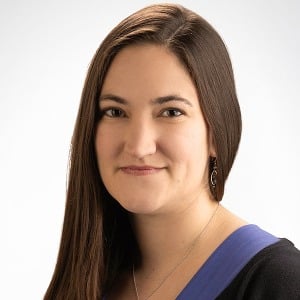
Annie Osborn
GFI ALUM
Co-founder of the Alt Protein Project
Check out related resources

The alt protein student resource hub
Use this repository of helpful tools, templates, tips, and tricks to turn your university into an engine for alternative protein innovation.

Building alternative protein courses and majors
This guide lays out the steps to build alternative protein courses and majors at your university.

Stimulating alternative protein research at your university
This guide will give you the skills and tools to kickstart alternative protein research at your university.

Generating awareness about alternative proteins
In our guide, you’ll learn about the steps needed to raise awareness and excitement about alternative proteins throughout your university.

